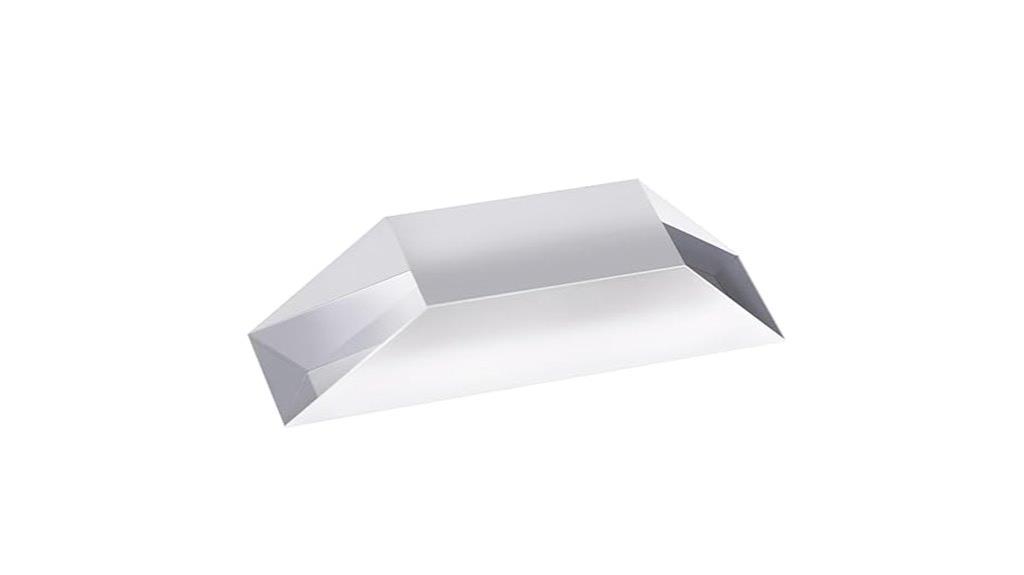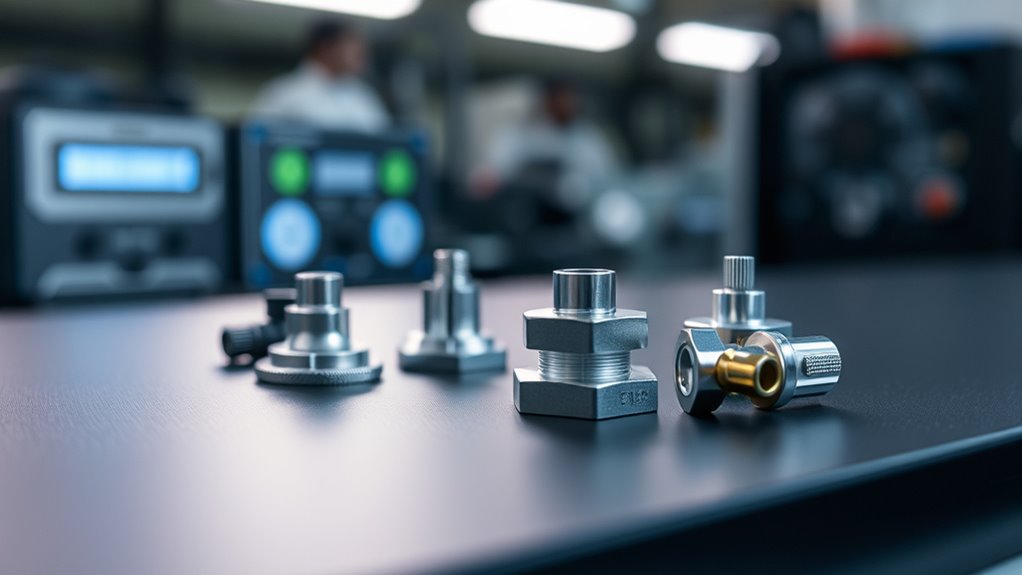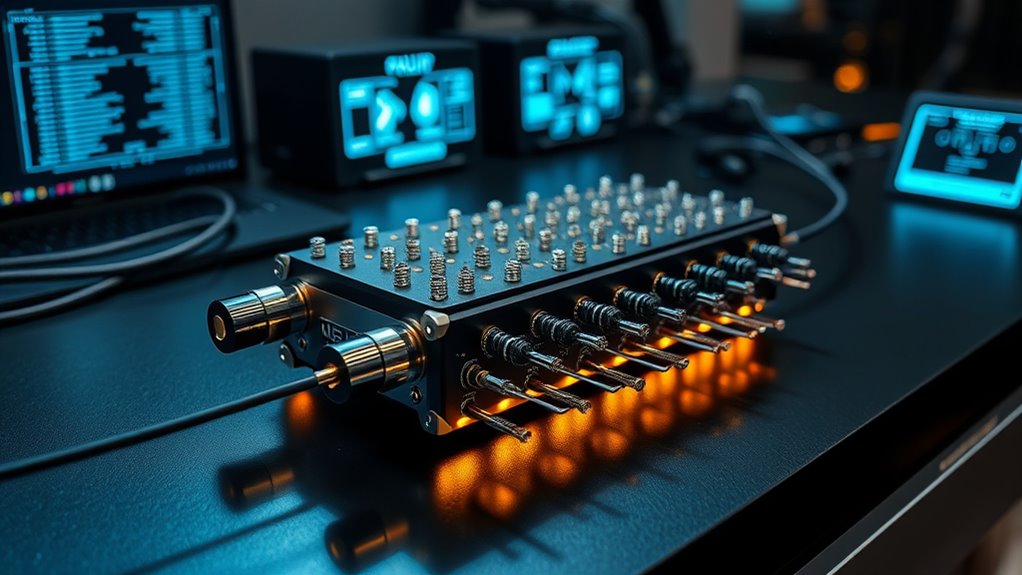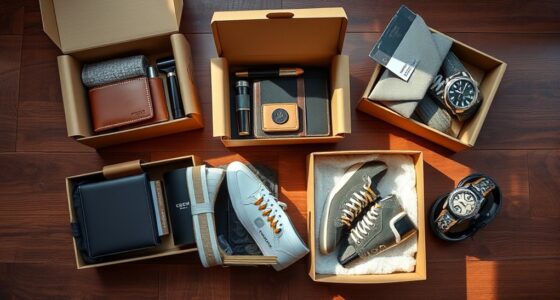For precision control in 2025, I recommend a beam steering optics kit featuring high-quality uncoated K9 dove prisms with dimensions like 20×28.28x80x20mm. It should offer excellent optical compatibility, stable mounts, and a wide rotation range for versatility. Prioritizing durability, surface finish, and appropriate coatings guarantees reliable performance. If you stay tuned, you’ll discover how to choose the best kit for your specific needs and budget.
Key Takeaways
- Select a kit with high-quality optical glass (e.g., K9) and coatings for maximum transmission and minimal aberrations.
- Prioritize stable, adjustable mounts with wide rotation ranges (up to 360°) for versatile beam control.
- Ensure compatibility with your wavelength and application, considering material durability and surface quality.
- Balance performance features with cost, focusing on long-term reliability and maintenance efficiency.
- Choose a kit offering precision, durability, and comprehensive accessories for optimal control in 2025 applications.
Prism Size:ABCH=20×28.28x80x20mm Uncoated K9 Dove Prisms

If you’re working on high-precision optical experiments, the Prism Size ABCH=20×28.28x80x20mm Uncoated K9 Dove Prisms are an excellent choice. These prisms are designed for beam steering, image rotation, and spectroscopic applications, making them versatile for research setups. Crafted from high-quality H-K9L optical glass, they offer precise dimensional tolerances and a surface quality of 60/40. Their ability to invert images by 180° and double rotation angles enhances experimental accuracy. Plus, they can be customized with rotating holders, ensuring they fit seamlessly into your optical system for reliable, high-precision results.
Best For: researchers and optical engineers performing high-precision optical experiments requiring image rotation and beam steering capabilities.
Pros:
- High-quality H-K9L optical glass ensures durability and consistent optical performance.
- Precise dimensional tolerances (+0.0/-0.2mm) provide reliable integration into optical setups.
- Ability to invert images by 180° and double rotation angles enhances experimental versatility.
Cons:
- Uncoated surface may lead to higher light loss compared to coated prisms.
- Limited to specific sizes; customization options may be required for unique setups.
- Surface quality of 60/40 might be less suitable for extremely sensitive optical applications demanding ultra-smooth surfaces.
Factors to Consider When Choosing Beam Steering Optics Kits

When selecting a beam steering optics kit, I focus on several key factors to guarantee optimal performance. I consider compatibility with my existing optical system, the quality of prism materials, and the stability of mounts and adjustment ranges. Wavelength suitability and mechanical robustness also play vital roles in making the right choice.
Optical Compatibility Requirements
Choosing the right beam steering optics kit requires careful attention to optical compatibility to guarantee ideal performance. First, ensure the kit matches your system’s wavelength range to avoid losses and aberrations. Verify that components like prisms and mirrors are made from materials with appropriate refractive indices for your application. Also, confirm that the size and shape of the optics fit within your system’s spatial constraints and mounting options. Optical coatings must be suitable for your use to maximize transmission and reduce reflections. Finally, check that the mechanical interfaces and connectors are compatible with your existing setup for seamless integration. Paying close attention to these compatibility factors helps ensure reliable operation and excellent beam control in your system.
Prism Material and Quality
Selecting the right prism material directly affects the overall performance of your beam steering setup. I recommend high-quality optical glass, like K9, because it offers excellent clarity, high light transmission, and durability. The surface quality of the prism is vital; a 60/40 finish minimizes distortions and guarantees accurate image inversion and rotation. Precise dimensional tolerances (+0.0/-0.2mm) are essential for proper alignment and consistent optical behavior. Choosing uncoated prisms can lead to some light loss and back reflections, which may reduce brightness and contrast. Additionally, the material’s optical properties determine whether the prism suits specific applications, such as spectroscopic experiments or image rotation tasks. Overall, investing in quality material and manufacturing standards guarantees your beam steering system performs reliably and accurately over time.
Mechanical Stability and Mounts
Ensuring mechanical stability in beam steering optics kits is essential for maintaining precise alignment throughout your experiments. Stable mounts made from high-quality materials minimize vibrations and mechanical flexing, which can otherwise cause drift and reduce accuracy. Adjustable mounts with fine-tuning features make accurate positioning easy, saving time and effort. Rigid, well-designed mounting structures withstand environmental factors like temperature fluctuations and mechanical shocks, ensuring consistent performance over time. Additionally, these mounts should allow for quick installation and removal of optical components without sacrificing stability or alignment. Focusing on durability, adjustability, and ease of use helps guarantee the optical setup remains steady, reliable, and precise—crucial for achieving ideal results in your experiments and maintaining control in demanding applications.
Rotation and Adjustment Range
The rotation and adjustment range of beam steering optics kits directly affect how flexibly you can direct your laser beam. A wider rotation range, from a few degrees up to 360°, allows for more versatile beam positioning, which is vital for complex setups. Precise adjustment mechanisms like gimbal mounts, rotary stages, or prism rotators ensure accurate control within that range. However, some kits have mechanical stops or limited rotation features that restrict movement, reducing flexibility. It’s also important that the rotation is smooth and backlash-free, as this guarantees reliable alignment and stable beam steering during experiments. Selecting a kit with an appropriate rotation and adjustment range helps you achieve both wide-angle steering and fine angular control, essential for high-precision optical applications.
Wavelength Range Suitability
Choosing the right beam steering optics kit requires careful attention to its compatibility with your laser’s wavelength range. If the optics aren’t suited for your light source, performance drops, and efficiency suffers. Different materials and coatings are optimized for specific wavelengths, affecting how well they transmit or reflect light. Ensuring the components can handle your laser’s spectrum prevents degradation or performance loss over time. Using optics matched to your wavelength minimizes the need for extra filters or adjustments, streamlining setup and operation. It’s essential to verify that prisms, mirrors, and lenses perform reliably within your required range. Proper compatibility ensures precise control, high accuracy, and consistent results, making wavelength range suitability a critical factor in selecting your beam steering kit.
Surface Finish and Coatings
Have you considered how surface finish and coatings affect the performance of beam steering optics? A high-quality surface finish, like 60/40, reduces scatter and enhances clarity, resulting in more precise control. Without coatings, optics may have higher reflection losses, decreasing efficiency. Applying anti-reflective coatings can dramatically increase light throughput, which is essential for spectroscopic and beam steering applications. The choice of coating material depends on the wavelength and environmental conditions, ensuring durability and peak performance over time. Surface finish and coatings work together to boost not just efficiency, but also the longevity of the optics. When selecting a beam steering kit, these factors are critical for maintaining high precision and reliability in demanding environments.
Budget and Cost Efficiency
When selecting a beam steering optics kit, it is vital to balance cost with the features and performance you need. I recommend considering your project budget carefully to guarantee affordability without sacrificing essential capabilities. Evaluate the long-term cost efficiency by checking the durability and maintenance needs of the components, as this can save money over time. Opt for kits with modular or customizable options, allowing upgrades or replacements that reduce future expenses. Analyze the performance-to-price ratio to get the best value for your investment. Also, factor in additional costs like installation, calibration, or accessories, which can influence the total budget. Prioritizing these aspects helps you choose an optics kit that delivers ideal performance while maintaining cost-effectiveness.
Frequently Asked Questions
How Does Temperature Affect Beam Steering Optics Performance?
Temperature critically impacts beam steering optics performance by causing thermal expansion and contraction of optical components. When it heats up, materials expand, potentially misaligning the system and reducing accuracy. Conversely, cold temperatures can make materials contract, also affecting precision. I always guarantee proper thermal management, like using temperature-stabilized housings or active cooling, to maintain ideal performance and prevent drift caused by temperature fluctuations.
Can the Prism Material Withstand High-Power Laser Applications?
Absolutely, prism materials can withstand high-power laser applications if chosen carefully. I always look for high-damage-threshold materials like fused silica or sapphire, which excel under intense laser exposure. These materials act like armor, resisting heat and optical breakdown. With proper selection and quality manufacturing, prism optics remain reliable even in demanding high-power environments, ensuring precise beam control without compromising safety or performance.
What Maintenance Is Required for Long-Term Optical Stability?
To guarantee long-term optical stability, I regularly clean the lenses with appropriate solvents and lint-free wipes to prevent dust and debris buildup. I also check for any misalignments and calibrate the system as needed. Additionally, I monitor the temperature and humidity levels to prevent environmental effects. Periodic inspections help catch potential issues early, so I can maintain peak performance and extend the lifespan of the optics.
Are There Compatibility Considerations With Specific Laser Wavelengths?
Yes, compatibility with specific laser wavelengths is essential. I always check the optics’ coating and material specifications to guarantee they match your laser’s wavelength. Using incompatible optics can cause reduced performance or damage. For example, certain coatings work best within specific wavelength ranges, so I recommend verifying these details beforehand. This way, you get maximum precision and longevity from your beam steering kit, avoiding costly mistakes.
How Does Beam Divergence Impact the Choice of Optics Kit?
Beam divergence greatly influences my choice of optics kit because it determines how precisely I can direct and focus the laser beam. A higher divergence means I need more advanced, adjustable optics to minimize spread and maintain accuracy over distances. Conversely, low divergence beams are easier to control, allowing for simpler optics setups. I always consider divergence to guarantee my system’s performance aligns with my specific precision and range requirements.
Conclusion
If you’re seeking precision, reliability, and versatility, this kit checks all the boxes. It offers the perfect balance of quality, stability, and affordability, making your beam steering tasks effortless. With the right prism, compatibility, and adjustable features, you’ll achieve consistent results. So, whether you’re experimenting or designing, this kit empowers you to control, refine, and excel—because when it comes to beam steering, excellence starts with the right choice.









